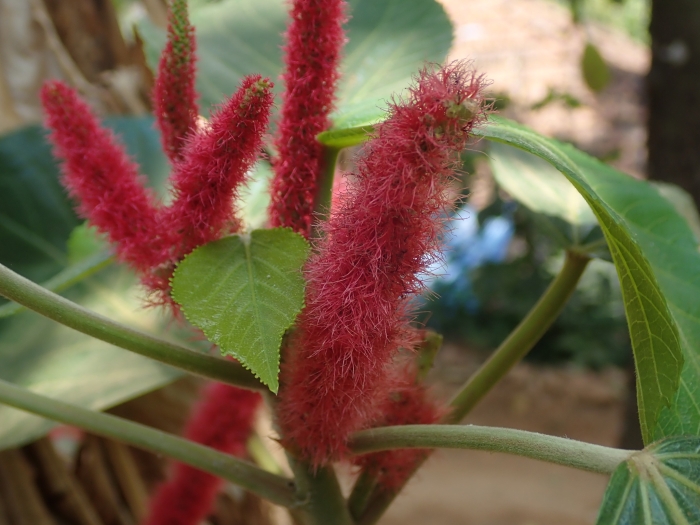Chenille Plant
(Acalypha hispida)
Chenille Plant (Acalypha hispida)
/
/

© Daniel Cahen
CC BY 4.0
Image By:
© Daniel Cahen
Recorded By:
Copyright:
CC BY 4.0
Copyright Notice:
Photo by: © Daniel Cahen | License Type: CC BY 4.0 | License URL: http://creativecommons.org/licenses/by/4.0/ | Uploader: danielcahen | Publisher: iNaturalist |

























Estimated Native Range
Summary
Acalypha hispida, commonly known as chenille plant or red-hot cat tail, is an evergreen shrub native to the moist, tropical forests of Indonesia and Australasia. It can grow to a height of 5-12 feet with a spread of 3-6 feet. The chenille plant is characterized by its large, oval to heart-shaped leaves and distinctive, pendulous catkins that are bright red or purple, resembling soft, fuzzy caterpillars. These catkins can grow up to 18 inches long and are most showy from late spring to fall, attracting attention for their unique texture and color.
The chenille plant is valued for its ornamental catkins and lush foliage, making it a popular choice for tropical-themed gardens, as a potted houseplant, or in conservatories. It requires a warm, humid environment and does not tolerate temperatures below 16°C (60°F). It prefers loose, well-draining, organic-rich soil and benefits from regular watering and feeding during the growing season. Partial shade is ideal, though it can tolerate full sun in cooler climates. While it can be pruned to maintain shape, it is generally low-maintenance. Gardeners should be aware that Acalypha hispida can become invasive in tropical and subtropical regions outside its native range due to its rapid growth and ability to spread through seed dispersal.CC BY-SA 4.0
The chenille plant is valued for its ornamental catkins and lush foliage, making it a popular choice for tropical-themed gardens, as a potted houseplant, or in conservatories. It requires a warm, humid environment and does not tolerate temperatures below 16°C (60°F). It prefers loose, well-draining, organic-rich soil and benefits from regular watering and feeding during the growing season. Partial shade is ideal, though it can tolerate full sun in cooler climates. While it can be pruned to maintain shape, it is generally low-maintenance. Gardeners should be aware that Acalypha hispida can become invasive in tropical and subtropical regions outside its native range due to its rapid growth and ability to spread through seed dispersal.CC BY-SA 4.0
Plant Description
- Plant Type: Shrub
- Height: 4-6 feet
- Width: 5-8 feet
- Growth Rate: Moderate
- Flower Color: Pink, Red
- Flowering Season: Spring, Summer, Fall
- Leaf Retention: Evergreen
Growth Requirements
- Sun: Full Sun, Part Shade
- Water: Medium
- Drainage: Medium, Slow
Common Uses
Border Plant, Potted Plant, Showy Flowers
Natural Habitat
native to the moist, tropical forests of Indonesia and Australasia
Other Names
Common Names: Philippine-Medusa , Philippines Medusa , Bristly Copperleaf , Red-Cattail , Red-Hot Cat’s Tail , Red Hot Cat Tail
Scientific Names: Acalypha hispida , Acalypha densiflora , Acalypha hispida var. sanderi , Acalypha sanderi , Acalypha sanderi , Acalypha sanderi subsp. alba , Caturus spiciflorus , Ricinocarpus hispidus , Ricinocarpus spiciflorus
GBIF Accepted Name: